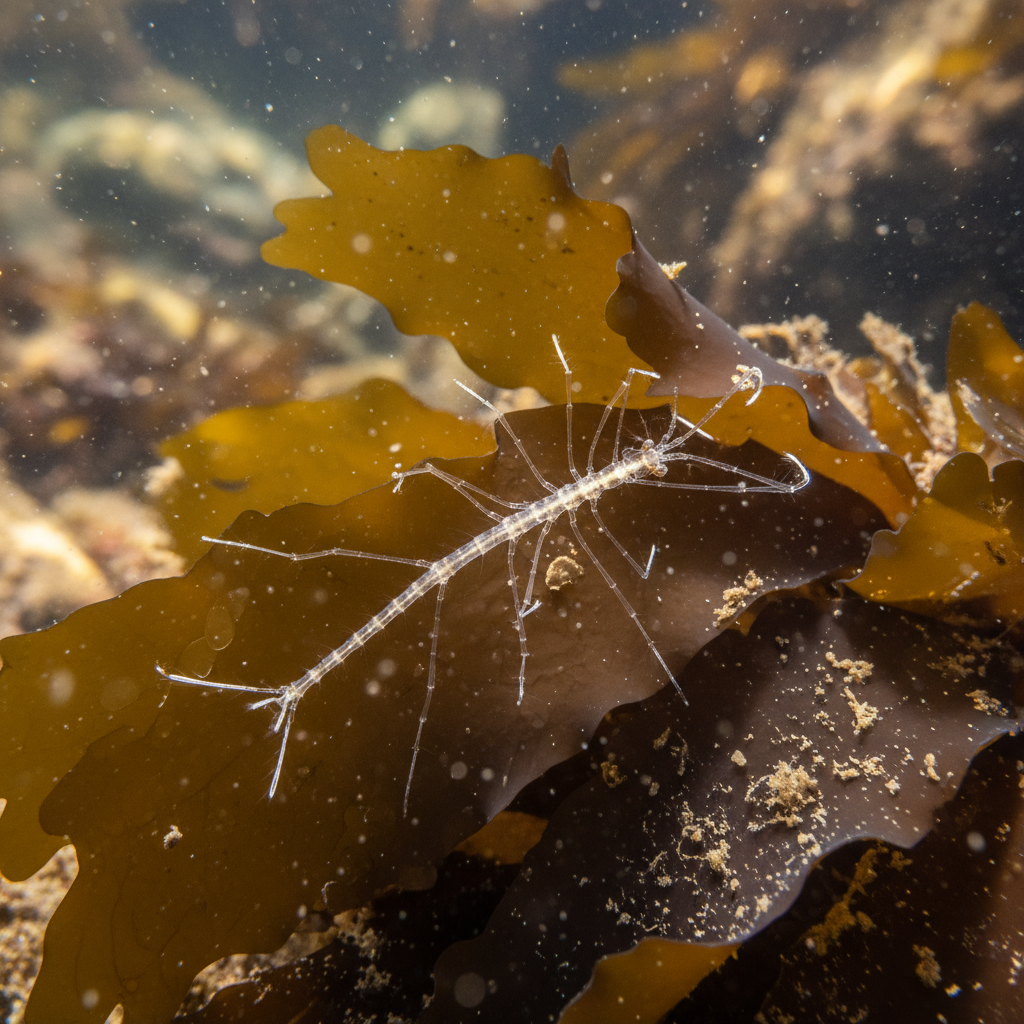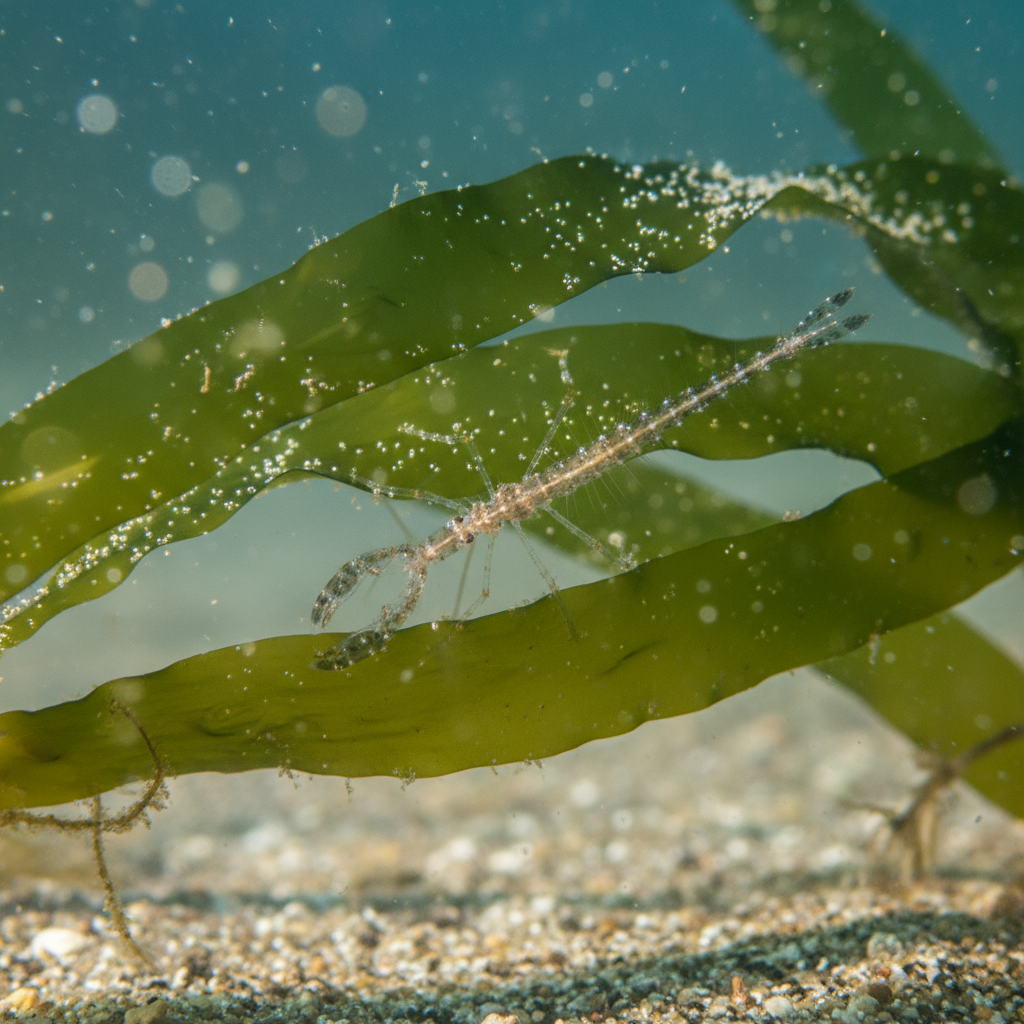Caprella: Morphology, Classification, Habitat, and Ecology of Skeleton Shrimps
Caprella is the largest genus within the family Caprellidae, commonly known as skeleton shrimps. These amphipod crustaceans are recognized for their slender, elongated, and stick-like bodies that give them a unique appearance resembling skeletons or ghostly forms. Found predominantly in marine environments, Caprella species play critical roles in benthic communities, often living attached to seaweeds, sponges, hydroids, and man-made structures such as docks and buoys. Their flexible feeding strategies and morphological adaptations allow them to thrive in diverse ecosystems. Their study aids in understanding invasive species dynamics, marine biodiversity, and ecological balance.
Classification of Caprella
| Taxonomic Rank | Name | Characteristics |
|---|---|---|
| Kingdom | Animalia | Multicellular eukaryotes |
| Phylum | Arthropoda | Joint-legged invertebrates with segmented bodies |
| Subphylum | Crustacea | Mostly aquatic arthropods with exoskeleton |
| Class | Malacostraca | Largest class of crustaceans with diverse morphology |
| Order | Amphipoda | Laterally compressed crustaceans with specialized appendages |
| Family | Caprellidae | Amphipods with slender, elongated bodies (skeleton shrimps) |
| Genus | Caprella | Skeleton shrimps with highly specialized limbs and feeding behavior |

Habit and Habitat
Caprella species inhabit shallow marine waters, often forming dense populations on macroalgae, seagrasses, hydroids, bryozoans, and artificial structures including oil rigs, floating docks, and aquaculture cages. They are found primarily in temperate to tropical regions. Their habitat preferences include complex benthic environments where they can anchor and reach plankton or detritus for feeding.
Caprella uses its slender body and grasping appendages to cling tightly to substrates in high-current zones, enabling it to avoid predators and efficiently exploit patchy resources.
Geographical Distribution
Species of Caprella are cosmopolitan, distributed across temperate and tropical marine systems worldwide. Some species, such as Caprella mutica, have become invasive outside their native range, spreading rapidly due to human-mediated transport such as ballast water and hull fouling.

General Characteristics
- It is a known as no-body crab with peculiar and extremely slender body and limbs.
- Body has elongated segments, consisting of cephalothorax and abdomen.
- First thoracic segments fuse with head forming cephalothorax containing eyes, antennules and antennae.
- Antennae are shorter than antennules. First antennae longer than the second.
- Thorax has six free segments and contains heart.
- Gills confined to third and fourth free thoracic segments on which the legs may be wanting while the rest have sub-chelate walking legs. Abdomen reduced to a small knob bearing a pair of rudimentary legs in the male
- . Male is smaller than the female. Structure of male is like female.
- It resembles in colour and form with polyzoan hydroid to which it mimics.
- It holds on by 3 pairs of long posterior prehensile thoracic legs.
- Body Form: Elongated, slender, and almost stick-like, with a narrow thorax and reduced abdomen.
- Size: Range from a few millimeters to a few centimeters, with males generally larger than females.
- Appendages: Reduced number of legs; first and second gnathopods often enlarged for grasping.
- Coloration: Highly variable; species-specific patterns from translucent pale to bold colors including green, brown, orange, red, and purple.
- Sensory Organs: Compound eyes and long, segmented antennae.
- Locomotion: Climb and cling rather than swim; agile and capable climbers.
Special Features
- Sexual Dimorphism: Males are larger and more robust, with pronounced gnathopods used in mating and competition.
- Feeding: Mainly detritivores and suspension feeders; also scrape algae and consume microorganisms.
- Reproduction: Females brood young in pouch formed by expanded plates (oostegites).
- Aggressive Behavior: Males often compete for females, exhibiting complex mating behaviors.
- Invasiveness: Some species spread rapidly and outcompete natives, altering local ecosystems.

Identification
Caprella species identification involves:
- Morphological detail of gnathopods, pereonites, and gills.
- Body size and proportions.
- Color pattern and setae distribution.
- Molecular analysis assists in distinguishing cryptic species.
- Geographical and ecological context.
Life Cycle and Reproduction
Caprella reproduces sexually with distinct males and females. Females carry eggs in the brood pouch until hatching. Juveniles resemble miniature adults and undergo direct development. Reproductive cycles vary but often peak during warmer months. Growth is relatively fast, supporting quick population expansion especially in invasive contexts.
Ecological Role and Importance
- Detritus Processing: Key players in benthic detritus breakdown and nutrient recycling.
- Prey Species: Important food source for fish and other benthic predators.
- Biofouling: Can colonize man-made structures, contributing to fouling communities.
- Invasive Species: Monitoring essential to manage impacts on native biodiversity.
- Study Models: Used to understand marine invasion biology, reproductive strategies, and benthic ecology.
Check sources
- https://en.wikipedia.org/wiki/Caprella_mutica
- https://www.sciencedirect.com/science/article/abs/pii/S1385110113000877
- https://www.mbai.org.in/uploads/manuscripts/ART%2016a%20JMBAI%2064-1__89-92727009525.pdf
- https://invasions.si.edu/nemesis/species_summary/95430
- https://www.sciencedirect.com/topics/agricultural-and-biological-sciences/caprella
- https://www.cabidigitallibrary.org/doi/full/10.1079/cabicompendium.107759
- http://www.aquaticinvasions.net/2007/AI_2007_2_4_Cook_etal.pdf
